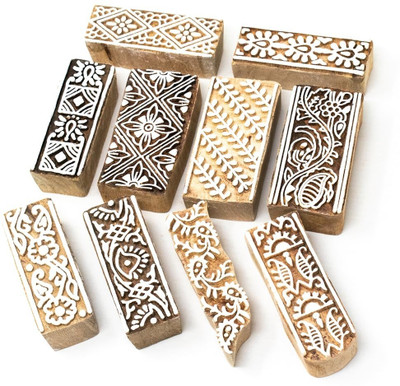Reniq Htag-2159 Printing Blocks(Pack of 10)
Quick Overview
Product Price Comparison
Wooden printing blocks, also known as woodblocks, are a traditional method of printing text, images, or patterns. This technique has been used for centuries in various cultures around the world, notably in East Asia and Europe. Here is an overview of the history, process, and uses of wooden printing blocks:HistoryEast Asia: The earliest known examples of woodblock printing come from China, dating back to the Tang dynasty (618-907 AD). This method was primarily used for printing textiles and later for printing texts, most famously Buddhist scriptures. The Diamond Sutra, printed in 868 AD, is considered the oldest surviving printed book.Europe: Woodblock printing in Europe started in the early 14th century. It was mainly used for printing images and playing cards. The technique contributed to the spread of knowledge during the Renaissance and the Reformation.ProcessDesigning: The process begins with a design or text that needs to be printed. This design is typically drawn or transferred onto a wooden block.Carving: Skilled artisans carve the design into the block, leaving the desired print areas in relief (raised) while cutting away the non-printing areas.Inking: The raised surfaces of the block are coated with ink or dye using a brush or roller.Printing: The inked block is pressed onto paper, fabric, or another substrate to transfer the image. This can be done by hand or with a press.UsesTextiles: Wooden printing blocks have been extensively used for printing on fabric, particularly in India where block printing on textiles is a rich tradition.Books and Prints: Before the advent of movable type, woodblock printing was a primary method for producing books and images in both Europe and Asia.Art: Woodblock printing is also a popular artistic technique, especially in Japan, where it is known as ukiyo-e. Artists like Hokusai and Hiroshige created famous woodblock prints during the Edo period.SignificanceCultural Impact: Woodblock printing played a crucial role in the dissemination of knowledge and culture, enabling the mass production of texts and images.Artistic Value: The technique is highly valued for its craftsmanship and aesthetic quality, contributing significantly to the world of printmaking and textile design.Modern UsageToday, wooden printing blocks are still used by artisans and artists who value the traditional methods and the unique qualities of block prints. They are appreciated for their historical significance and their ability to produce rich, textured prints that are difficult to replicate with modern printing techniques.


